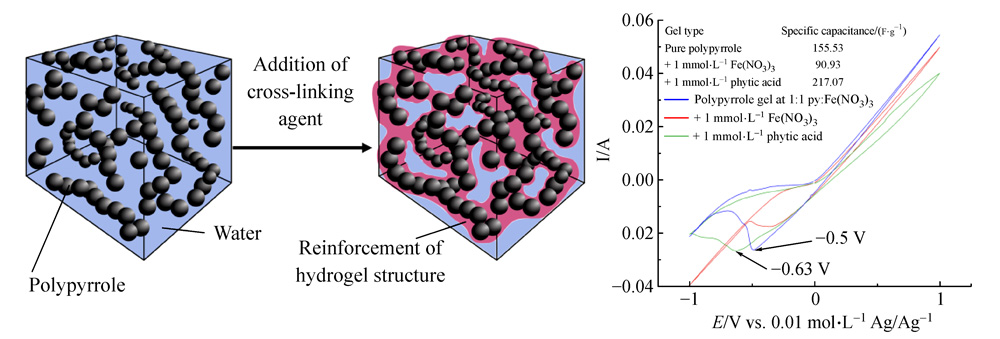SEM imaging was performed on freeze-dried samples using a Sirion FEG-SEM microscope. Figure 1 shows the effect of adding excess reactants to hydrogels made of 1:1 molar ratio pyrrole:ferric nitrate (which were typically the gels with the highest elasticity due to increased Fe
3+ concentration and secondary polypyrrole growth). Figure 2 shows the effect of adding excess ferric sulphate and phytic acid on the morphology of hydrogels made with a 1:1 molar ratio of pyrrole:ferric sulphate. It can be seen that adding excess Fe(NO
3)
3 led to polypyrrole formation in the voids of the pre-existing hydrogel, resulting in an extensive decrease in surface area and loss of nanosphere definition. However, addition of excess Fe
2(SO
4)
3 to polypyrrole hydrogels formed well-dispersed beads of secondary-made polypyrrole within the hydrogel structure without a loss in surface area. However, these interconnection points may help improve the network strength. Addition of phytic acid to either hydrogel resulted in a loss of surface area, as seen in Figs. 1(B) and 2(B). Upon addition, a gelatinous white substance was observed to form in the solution, which may be due to a reaction of phytic acid with excess sulphate anions not incorporated into the polypyrrole. These additions formed stiff gels with an absence of any microstructure, aside from a few large spheres which immersed in dense polypyrrole. Addition of KOH and NaHCO
3 resulted in much less agglomeration and loss of surface area. This is likely because K
+ and Na
+ are not sufficiently electrophilic to induce secondary polymerisation of pyrrole and thus grow the network. It was also seen that adding NaHCO
3 initially produced bubbles of CO
2 as it reacted with the H
+ ions produced by pyrrole polymerisation; these bubbles may help to increase the porosity of the gel. They also resulted in neutralisation of the polypyrrole, but after ageing it was seen that the pH returned to pH 2. This is an indication that secondary polymerisation of the pyrrole still occurs, which was also indicated by the presence of some interconnectivity observed when NaHCO
3 was used—the [CO
3]
2− may be acting to ‘regenerate’ the Fe
3+ and allow it to further initiate the formation of radical cations of pyrrole, and thus some secondary polymerisation of pyrrole occurs [
17].















